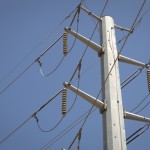How Austin Lost Two Flood Gauges When It Needed Them Most

Jorge Sanhueza-Lyon/KUT News
Rescue teams on the scene in Southeast Austin assisting people stranded in rising flood waters. Heavy rains caused serious flooding in Onion Creek on Halloween.
Early on the morning of October 31st, as waters rose to historic levels in Onion Creek, two of the flood gauges that officials rely on to monitor water levels weren’t working. The flooding heavily damaged more than 600 homes and killed five. One gauge was completely submerged by water, damaging the equipment, which isn’t waterproof. But the other had malfunctioned before the flooding even began. And more than two weeks after the Halloween Floods, city and emergency officials still don’t know why.
The gauges, which are managed by the U.S. Geological Survey (USGS), provide emergency responders with critical information during floods about how fast and how high flood waters are rising. In Austin, there are 130 flood gauges that measure water levels, rainfall and low-water crossings 24 hours a day.
The second gauge, according to National Weather Service Hydrologist Mark Lenz, was having problems on October 30th, before the rains started. Lenz was stationed at the Weather Service station in New Braunfels that night, monitoring flood gauges throughout Central Texas.
“We noticed that it was a little lower than it should be on the afternoon before. So then the heavy rain started to run off and move downstream, and we started to notice that the gauge was responding, but we felt like it was a little lower than what it should be,” he says.
Lenz says they notified the U.S. Geological Survey of the malfunction before it started raining, but the agency wasn’t able to get out to the Onion Creek gauge until 8 am the next morning—after the flood waters had already risen to historic levels.
The gauges are used across the country, says David Maidment, with the University of Texas’ Center for Research in Water Resources.
Maidment says the gauges are basically vertical pipes sunk into the ground at creeks and rivers with a pressure-sensing device that measures the elevation of the water. At the top of the gauge, there’s a transmitter. In Austin, once a storm starts, a signal is sent out that gets picked up by the city’s Emergency Operations Center. Every time it changes, a click gets sent off, letting officials know how high the levels are.
“We noticed the gauge kept continuing to rise, but we weren’t sure how accurate it was,” Lenz says.
But by 3 a.m. Halloween morning, the flow of data from two gauges on Onion Creek simply stopped. Lenz says when that happens, the Weather Service must rely on a backup: sending USGS crews out to measure water levels in the field.
Lenz says in the case of the Halloween floods, the backup plan worked. USGS officials were able to provide updates on the flood levels even though the gauges had failed. But when flood gauges do fail, it makes it hard to predict how high water levels will go.
“We could come out with a forecast of 25 feet and it actually crests at 29 feet. That could take you from a moderate category flood to a major category flood. It depends on the location and criteria set up there,” Lenz says. In his 24 years with the National Weather Service, Lenz says he has seen a flood gauge malfunction one other time. In that instance, the gauge was also submerged in water.
More than two weeks after the floods, officials say they are still in recovery mode and have not yet reviewed the flood response. But immediately after the floods, there was a lack of consensus about what exactly happened to the flood gauges and how their failure impacted the city’s response.
At a town hall meeting the week after the floods, Police Chief Art Acevedo apologized to Dove Springs and Onion Creek residents for their response. “We relied more on technology and gauges that weren’t working properly instead of relying on you. And for that I apologize from the bottom of all of our hearts,” Acevedo said. “That is a fact. We have had some lessons learned as first responders, Austin Police, Austin Fire and Austin EMS.” The crowd applauded.
But Austin’s Deputy City Manager Michael McDonald disagrees with Acevedo’s assessment.
“The way [Acevedo] characterized it is that the gauges had failed. The chief is not in the geological services, and if you were to talk to him again, he will tell you, his understanding, they didn’t fail, they were knocked completely out,” McDonald says.
Yet both Mark Lenz with the National Weather Service and USGS officials say that’s not correct either.
They say the flood gauge is still standing, While the USGS has fixed both gauges, they’re investigating why one of the gauges had malfunctioned before the floods began, leaving officials without measurements they typically rely on during floods.
